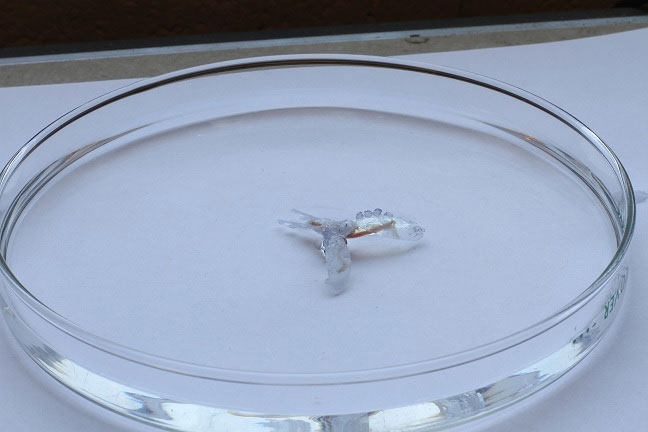Biohybrid Robot Uses Sea Slug’s Muscles
A robot that uses muscles from a sea slug’s mouth, nerves, and neurons to crawl with an inchworm-like movement, has been developed by researchers at Case Western Reserve University. The researchers are working in the nascent field of biohybrid robotics, which merges the fields of robotic and tissue engineering to create robots powered by living muscle tissue or cells.
The Aplysia robot is comprised of the sea slug tissue along with components that have been 3D printed from a flexible material. The researchers wanted to create a device that could function outside the lab for environmentally monitoring in sensitive environments, said Victoria Webster-Wood, a research associate who leads the robotic sea-slug development.
“We want to be able to create robots that are safe to function around living organisms, so they need to be naturally compliant, like animals,” Webster-Wood said. “If a robot made of plastics and metals monitoring coral reefs broke down, you’d have pollution in a sensitive environment.”
The first robot, created more than two years ago, uses muscle from the slug’s feeding apparatus, which is controlled by a cell-powered external electrical field, to propel the robot. When the muscle contracts via the electrical force, the robot scoots forward, Webster-Wood said.
The feeding muscle is ideal as it’s quite thin and doesn’t need vascular tissue for support, she added.
“The great thing about tissue from sea slug is we have muscles that can be used as actuators and they have a fairly well understood neural system,” Webster-Wood said.
The sea slug is uniquely qualified to provide biocompatible materials because of its living conditions. The researchers use slugs that spend their lives within rocks along the coast in the California intertidal reef region, which is above water at high tide, below water at low tide, she added.
“When the tide comes in, they’re in a lot more water at a consistent temperature,” she said. “But when water goes out, it becomes shallow and if the sun is shining in shallow water, temperatures increase. If it rains, fresh water is introduced. They also see mechanical disturbances when tides comes in and out.”
The team is now looking at using the slug’s ganglia—the bundles of neurons and nerves that normally conduct signals to the muscle as the slug feeds—as an organic controller. Using attached neurons to stimulate the muscle should cause the robots to move forward with greater force and less muscle fatigue, Webster-Wood said. The researchers are currently running studies to see if their theory holds up. The ganglia acts as a natural controller, doing away with the need for the electrical force.
The study itself is relatively new within the biohybrid robotic field. “The vast majority of biohybrid robots either move because of spontaneous contraction, like with heart cells, or are paced with an eternal electrical field like we’d been doing,” Webster-Wood said.
In tandem with the neurological research, the Case Western team also developed a new body design for the robot inspired by the inchworm. The new design includes isolation wells on the body into which ganglia are placed to separate the neuron and nerve bundles from the muscle. Because the slug’s feeding apparatus opens and closes rhythmically, the robot moves forward following the same pattern.
“Right now we’re exploiting the natural bite pattern, so when you apply a chemical signal to the ganglia it bites automatically to expand and contract like an inchworm,” she said. “But in the future we could highjack its natural system to program it to do things like move toward the light,” Webster-Wood said.
The future for these biocompatible robots is bright: as in, potentially glowing green.
“We could send a swarm of these into a body of water, like Lake Erie, to monitor for toxic algae blooms or a leading pipeline,” Webster-Wood said. “And they could be outfitted with transmitters or illuminated with green fluorescent protein to make them bioluminescent, like jelly fish, so they can be monitored via helicopter of plane to find the bloom or the leak.” Jean Thilmany is an independent technical writer.



Comments are closed, but trackbacks and pingbacks are open.